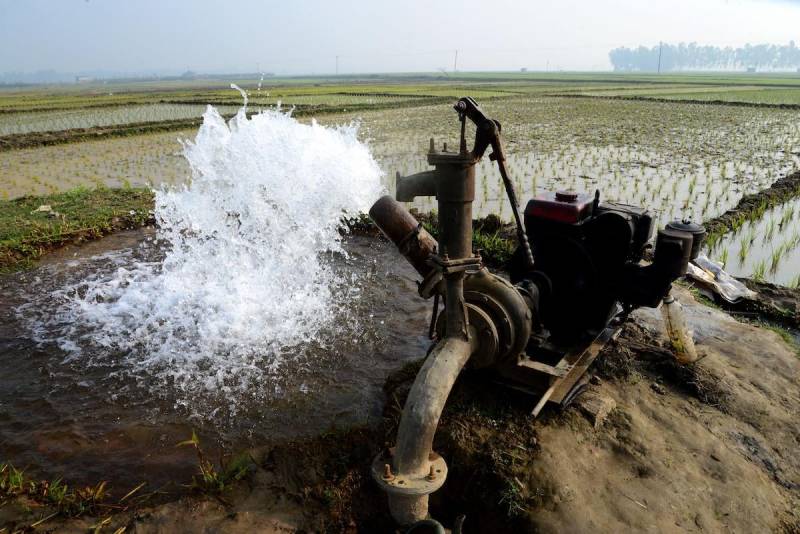
The caretaker government is actively considering the exploration of vast Indus Basin aquifers as a strategy to attract foreign investment and bolster exports, primarily for corporate farming. This move is aimed at addressing the challenges posed by the decaying irrigation infrastructure and unpredictable weather patterns, with the goal of unlocking the potential of the Indus Basin for cultivating untapped lands and ensuring sustainable water supplies for farmers.
With exact data yet to be collected, the roughly estimated volume of these aquifers is equivalent to the three-year medium flow of the Indus River. In addition to boosting foreign exchange reserves and ensuring food security, the Indus Basin aquifers hold the promise of meeting the increasing drinking water needs of a rapidly growing population. Many urban areas are grappling with deteriorated water quality, leading to preventable but deadly diseases. Thus, the utilization of these underground water resources not only serves agricultural interests, but also addresses critical issues related to public health in expanding cities.
While the promotion of agriculture, coupled with rail and road networks has boosted population growth in the arid regions, the unsustainable water supplies due to uncertain weather conditions and decaying irrigation infrastructure has forced people to drink brackish water. This is particularly a case with the former princely state of Bahawalpur which has undergone critical conditions due to cutting of supplies in the perennial Sutlej River due to the Indus Basin Treaty with India. The irrational use of pesticides and chemical fertilizer other than wastewater from urban centers has also considerably deteriorated the underground water quality subjecting population to deadly diseases like hepatitis C and cancer.
There is no second opinion about the Indus Basin aquifers potential for economic turnaround or uplifting teeming millions on the brink of malnutrition and in need of quality drinking water. But the problem is that the Indus Basin aquifers are already under stress due to damming of rivers and vast canal network to feed lands far away from the flood zones causing salinity, water logging and contamination of scarce underground water resources due to unsustainable agricultural practices, including irrational use of pesticides and chemical fertilizer.
To prevent over-extraction and depletion of the water table, it is imperative to establish and enforce water use limits based on scientific assessments of aquifer recharge rates. This approach ensures a balanced utilization of water resources, safeguarding against the long-term consequences of excessive extraction.
Needless to say, the situation on the ground calls for cautious approach as for Indus Basin aquifer utilization is concerned. Our foreign investment needs are paramount and pressing given low productivity adversely affect balance of payment and untapped natural resources at hand but rational utilization of pristine underground water must reflect our sense of accountability not only to the present, but also future generation.
Ensuring the sustainable use of the Indus Basin aquifers for socio-economic development in Pakistan requires a comprehensive and cautious approach. While the pursuit of foreign investment and economic turnaround is crucial, a deep sense of accountability to both present and future generations is paramount.
A fundamental element of sustainable water management involves the establishment of a robust monitoring system. This system would assess both the quantity and quality of pristine water within the Indus Basin aquifers. Such monitoring is essential for enforcing regulatory mechanisms that minimize losses associated with water supplies and use. Continuous real-time data collection on underground water levels, quality, and extraction rates is imperative to comprehend aquifer dynamics and promptly intervene in unsustainable trends.
To prevent over-extraction and depletion of the water table, it is imperative to establish and enforce water use limits based on scientific assessments of aquifer recharge rates. This approach ensures a balanced utilization of water resources, safeguarding against the long-term consequences of excessive extraction. Additionally, promoting crop diversification and rotation, along with advocating for precision agriculture, can optimize water usage. These practices not only enhance water efficiency but also reduce the risk of groundwater contamination associated with the irrational use of pesticides and chemical fertilizers.
Soil conservation practices, such as cover cropping and agroforestry, play a pivotal role in enhancing soil structure and water retention. By implementing these practices, the overall sustainability of the agricultural ecosystem can be significantly improved. Furthermore, community engagement and education are vital components of a successful strategy other than fostering awareness about the importance of sustainable water use and disseminating knowledge on efficient agricultural techniques empowers local communities to actively participate in preserving water resources.
Investment in research and development is critical for discovering innovative water management technologies that contribute to the long-term preservation of the Indus Basin aquifers. Governments and relevant authorities should play a proactive role in incentivizing farmers to adopt sustainable practices. Financial incentives, subsidies, or tax breaks can motivate farmers to embrace methods that promote water conservation and responsible agriculture.
Investment in research and development is critical for discovering innovative water management technologies that contribute to the long-term preservation of the Indus Basin aquifers.
Collaboration among stakeholders is essential for the success of integrated water resource management plans. This collaboration should include farmers, government agencies, civil society, NGOs and researchers. An inclusive approach ensures that the entire water cycle is considered in planning and decision-making processes, promoting a holistic understanding of the complex interactions within the ecosystem.
By integrating these strategies, agriculture in the Indus Basin can achieve a harmonious balance between meeting current food demands and safeguarding underground water resources for the benefit of future generations. The Indus Basin aquifers, if managed sustainably, have the potential to not only address immediate challenges but also contribute significantly to the long-term socio-economic development of Pakistan. This sustainable approach will not only secure water resources but also enhance food security, promote economic growth, and mitigate the impact of unpredictable weather patterns, ensuring a more resilient and prosperous future for the nation.

